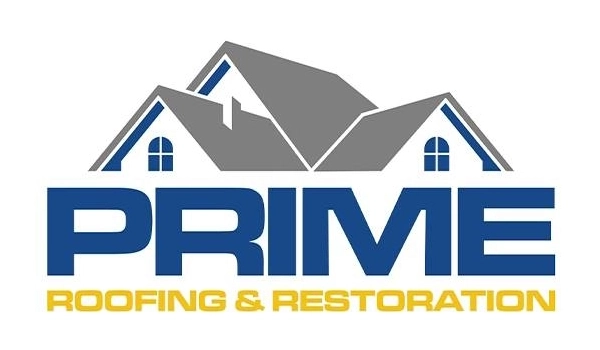When Hail Strikes: Understanding Your Need for Expert Assessment
Hail damage roofers are specialized contractors who identify, assess, and repair roof damage caused by hailstorms. If you’re searching for reliable Alabama roofing experts after a recent storm, understanding how these specialists operate can save you time and money. These professionals have the expertise to spot subtle damage that untrained eyes often miss, help steer insurance claims, and ensure proper repairs that prevent costly future problems. Their training goes beyond standard roofing; they understand storm dynamics, how hail of different sizes and densities affects various materials, and the specific documentation insurance companies require.
What Hail Damage Roofers Do:
- Comprehensive inspections – Identify both visible and hidden damage
- Insurance claim assistance – Document damage and work with adjusters
- Expert repairs – Use proper techniques and materials for lasting fixes
- Storm damage prevention – Advise on protecting your roof from future storms
Hailstorms cause approximately $1 billion in property damage annually across the United States, with over 4,400 severe hail reports recorded in 2022 alone. When those ice balls start pounding your roof, the aftermath can leave you feeling bruised and confused about what to do next.
The challenge isn’t just the obvious damage you can see from the ground. Hail creates hidden problems that worsen over time – weakened shingles, compromised seals, and microscopic cracks that eventually lead to leaks, mold, and structural damage. This insidious damage can compromise your home’s entire protective envelope, leading to saturated insulation, damaged drywall, and even electrical hazards. Without proper assessment and repair, what starts as minor cosmetic damage can turn into thousands of dollars in additional repairs.
That’s where the right roofing professionals make all the difference. This guide will walk you through identifying hail damage, understanding when to call for help, and choosing the right contractor to restore your roof’s integrity.
I’m Bill Spencer, owner of Prime Roofing & Restoration, and I’ve spent over five years helping Alabama homeowners steer the confusion that follows hailstorms. As experienced hail damage roofers, we’ve seen how proper assessment and timely repairs can save homeowners thousands in future damage costs.
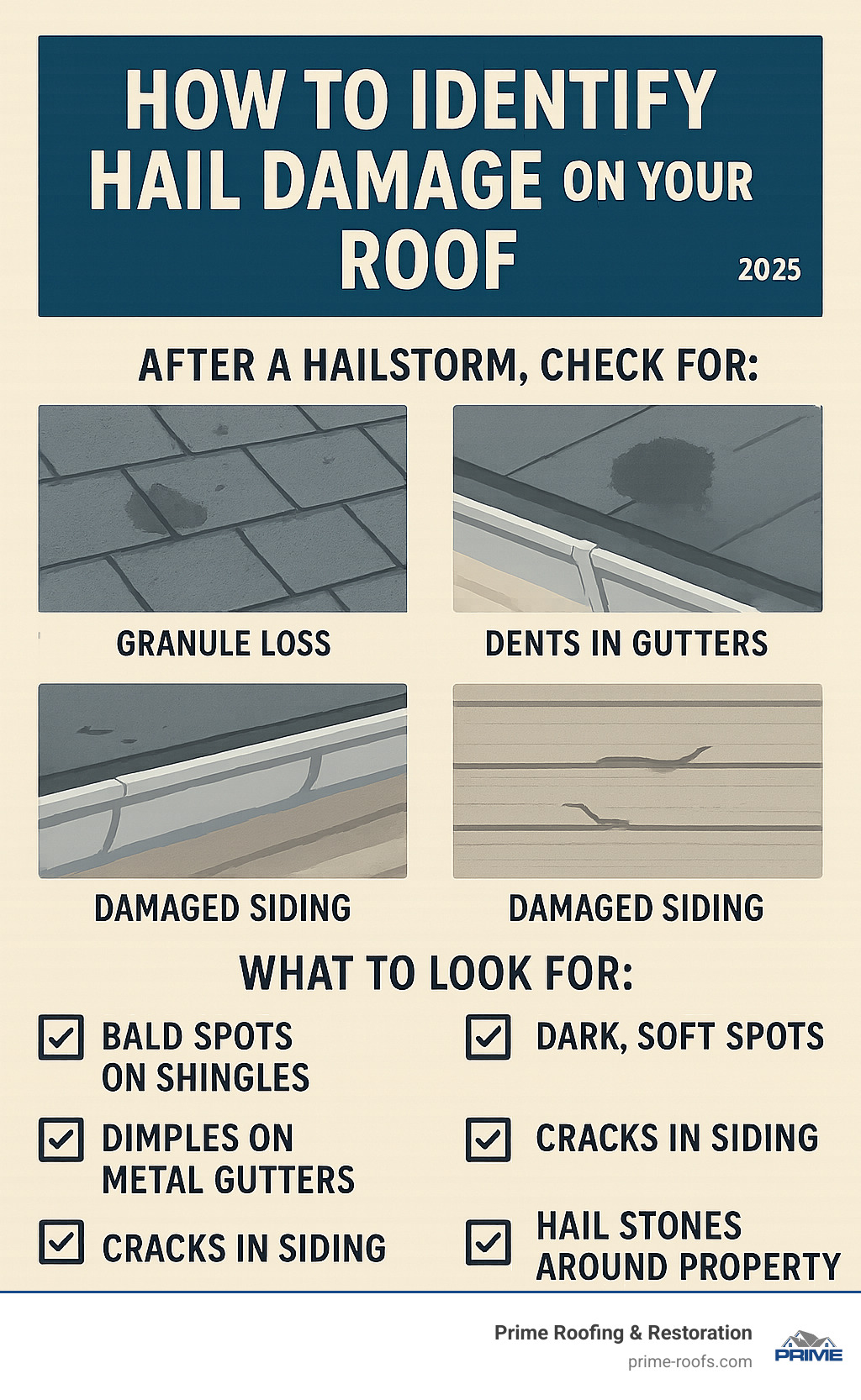
First Steps: What to Do Immediately After a Hailstorm
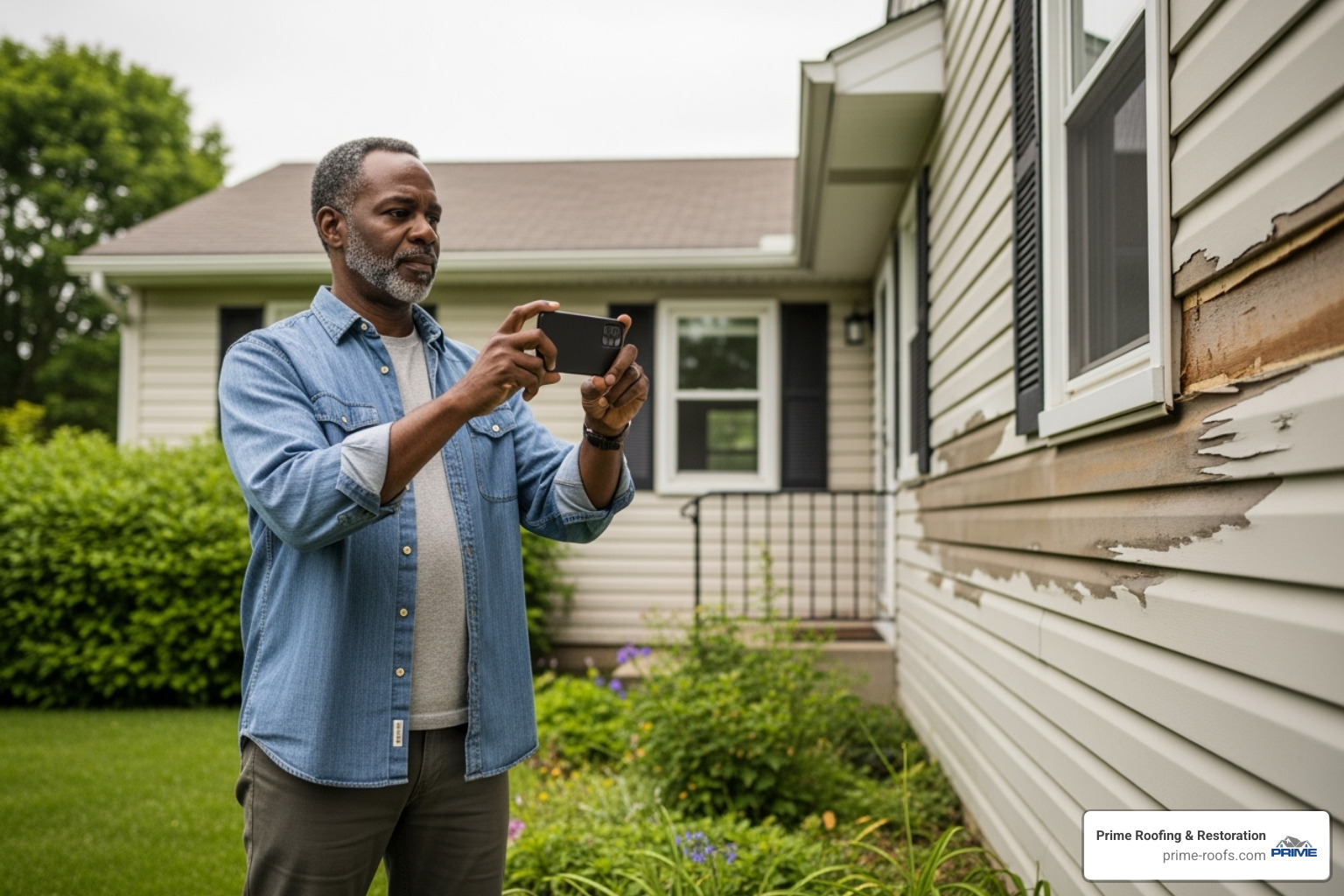
When the clouds clear, resist the urge to climb a ladder. Wet shingles and unseen impact points can turn even a low-pitch roof into a slip-and-fall hazard. Instead, circle your home at ground level and document every sign of damage you can safely see. Be mindful of other potential hazards like downed power lines, broken glass, or fallen tree limbs.
Key items for your checklist:
- Siding dents or cracks
- Gutter and downspout dings
- Dented AC units or other soft metal fixtures
- Window-screen tears
- Shingle granules collecting at downspout exits
Photograph each item—wide shots for context and close-ups for detail. Be methodical. Capture photos of all four sides of your house, plus any detached structures like sheds or garages. These pictures will become essential, time-stamped evidence if you decide to open an insurance claim.
If you spot a hole or missing shingle from the yard, cover the area with a tarp to prevent water intrusion until a professional can inspect. Tarping is temporary; a qualified roofer should verify the roof’s true condition as soon as possible.
For a step-by-step post-storm checklist, see our in-depth guide on What to Do After a Storm Damages Your Roof.
Decoding the Damage: How to Spot Signs of Hail on Your Roof
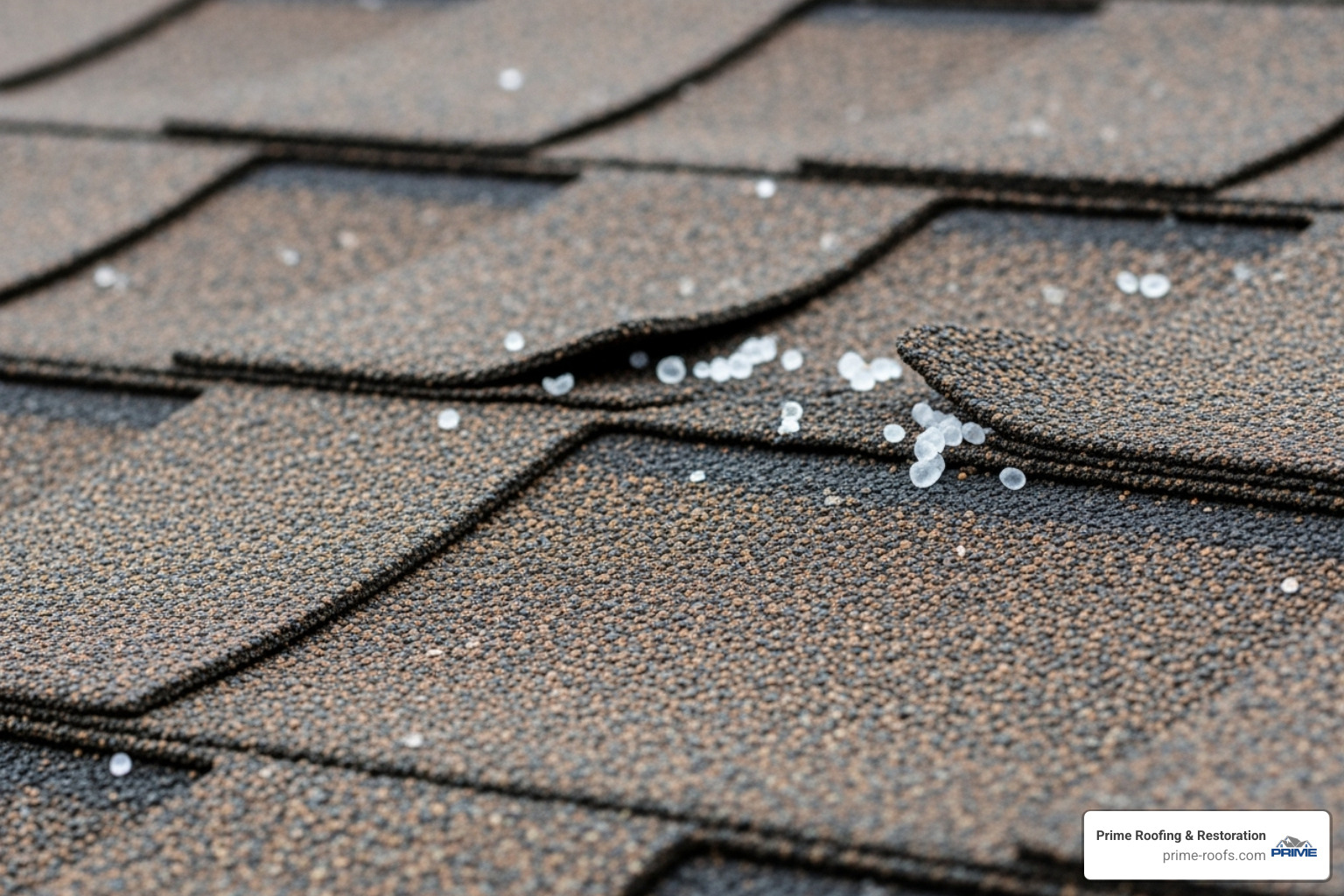
The harsh truth is that the most destructive hail impact is often invisible from your driveway. Professionals separate functional damage (the kind that lets water in) from cosmetic damage (the kind that weakens shingles over time).
Main factors that influence severity:
- Hail diameter, density, and wind speed
- Roof age and material condition
- Slope and orientation toward the storm
- Natural barriers such as nearby trees or taller structures
Quick Reference: Common Roofing Materials & Typical Hail Clues
| Material | Tell-tale Signs |
|---|---|
| Asphalt shingles | Bruising, granule loss, exposed mat. Granule loss is critical, as it exposes the underlying asphalt to UV rays, causing it to dry out and crack, drastically shortening the shingle’s lifespan. |
| Wood shakes | Fresh splits with sharp edges and no signs of weathering. Hail can shatter the wood, creating entry points for moisture that lead to rot and decay from within. |
| Metal panels | Visible dents, displaced seams, and compromised coatings. Dents may seem cosmetic, but they can break the protective finish, leading to rust and corrosion over time. |
| Clay/Concrete tile | Chips, cracks, or completely shattered tiles. Even small impact points can create hairline fractures that absorb water and break apart during freeze-thaw cycles. |
| Slate | Fractures, chips, or sheared edges. Slate is durable but brittle, and a significant impact can cause damage that requires a specialist to repair without damaging surrounding tiles. |
Ignoring “small” impacts is risky. Granule loss exposes the asphalt mat to UV radiation; splits in wood let moisture penetrate; dents in metal compromise protective coatings. Left unfixed, these issues lead to leaks, mold, and premature roof failure.
For a deeper visual guide, our article on How to Spot Roof Hail Damage breaks down what to look for on every material type.
The Professional Advantage: Why You Need Specialized Hail Damage Roofers
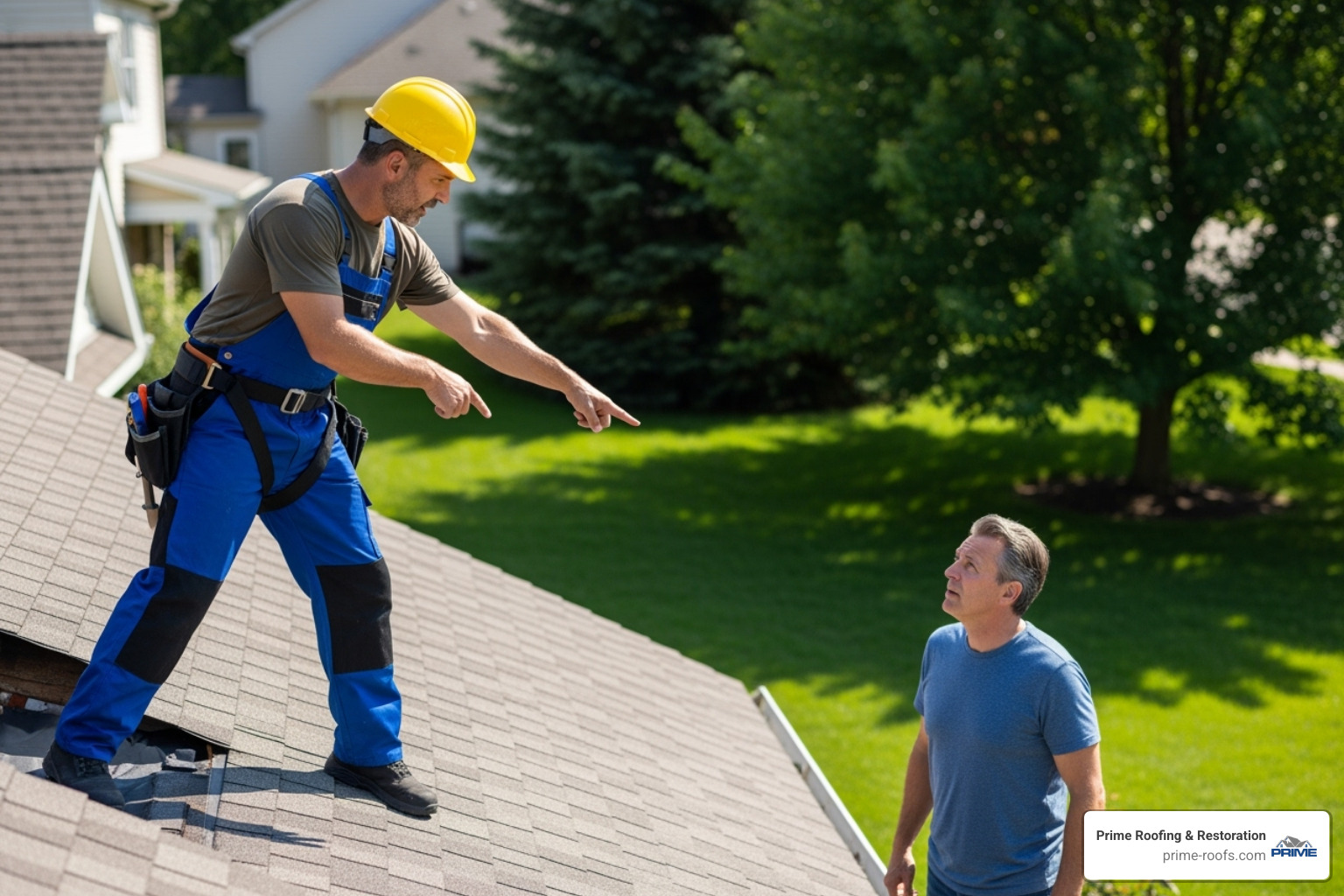
Hail leaves a complex pattern of stress on your roof that only trained eyes—and proper safety gear—can decode. Certified hail specialists don’t just swap damaged shingles; they evaluate the entire roof system, from flashing and vents to underlayment and decking, to ensure every component still performs as designed.
Why DIY Fixes Fall Short
- Safety: Impact-loosened shingles and wet decking put homeowners at serious risk of falls. A professional is trained and insured to work safely at heights.
- Hidden damage: Surface repairs often miss bruised underlayment, compromised seal strips, loosened fasteners, cracked vent collars, or damaged flashing around chimneys and skylights. These are the most common entry points for water, and only a thorough, systematic inspection will uncover them.
- Warranty concerns: Manufacturer warranties typically require professional repair methods and sometimes specific certified installers to remain valid. A DIY patch job using the wrong materials or techniques can instantly void your coverage, leaving you fully responsible for the cost of future failures.
Long-Term Protection
Pros not only restore current integrity but also recommend upgrades—such as impact-rated shingles or improved flashing—so the next storm does less harm. Good contractors back their workmanship with warranties that stay in force long after they leave the jobsite, giving you lasting peace of mind.
Navigating the Aftermath: Insurance, Costs, and Choosing Your Roofer
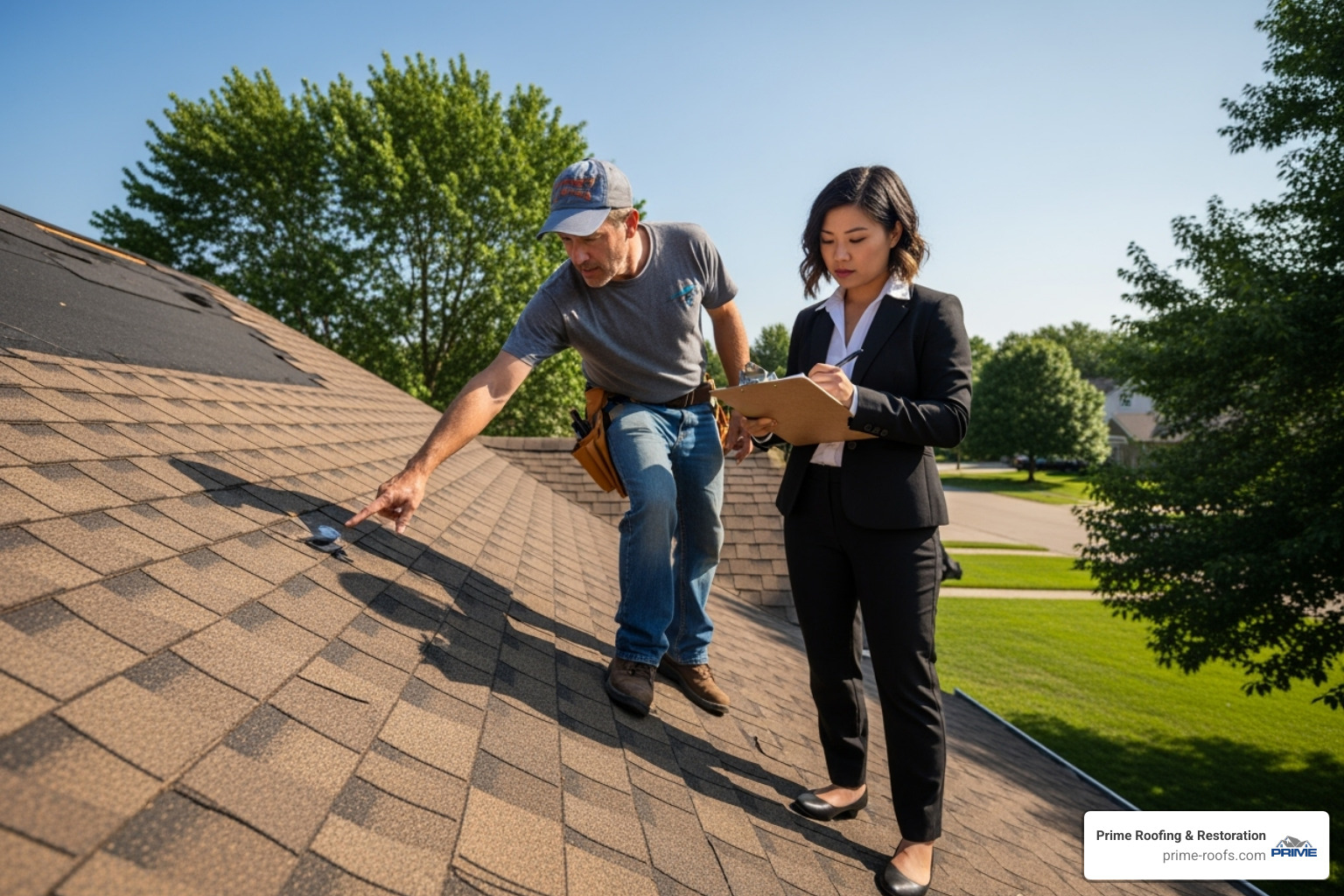
Understanding Your Insurance Claim
Most homeowners policies cover hail, but prompt reporting is essential. Provide your insurer with photos, dates, and a written summary of what was damaged. When the adjuster visits, having a trusted roofer present helps ensure no damage is overlooked. Your roofer acts as your advocate, speaking the same technical language as the adjuster and pointing out damage that aligns with industry standards for replacement. This collaboration can be the difference between a minor repair approval and a full roof replacement.
Know your policy type:
- ACV (Actual Cash Value): Pays depreciated value, meaning you cover the difference to install new materials.
- RCV (Replacement Cost Value): Pays the full cost to replace with new materials (minus your deductible), often paid in two installments.
Typical Repair Price Ranges
- Minor patch jobs: $150–$500
- Widespread shingle replacement: $500–$3,000
- Major structural fixes: $3,000–$7,500
- Full replacement (varies by size/material): $5,000–$15,000+
Variables include roof square footage, material choice, pitch, accessibility, and local labor rates. Mold remediation or interior ceiling repairs can add unexpected costs if water has already infiltrated.
Selecting a Reputable Contractor
- Choose a company with a permanent local address and storm history knowledge.
- Verify license plus liability and workers’ comp coverage.
- Read recent online reviews and call references.
- Insist on a detailed written estimate—materials, labor, timeline, and warranty.
- Be wary of out-of-state “storm chasers” pushing for on-the-spot signatures, offering to “waive” your deductible (which is insurance fraud), or using high-pressure tactics. A reputable local contractor will have a vested interest in the community and their long-term reputation.
Frequently Asked Questions about Hail Damage and Roofers
How long do I have to file a hail claim?
Policies often allow six months to a year, but the clock starts on the storm date, not the findy date. Reporting damage as soon as possible is crucial to avoid coverage disputes and ensure you meet your policy’s deadlines.
Will filing raise my premium?
A single weather-related claim usually doesn’t affect individual rates, as they are considered an “Act of God.” However, widespread damage in a region can lead to area-wide premium increases for all policyholders, regardless of whether they filed a claim.
Can pea-sized hail really hurt my roof?
Yes. While it may not shatter a shingle, small hail driven by 60-mph winds acts like a sandblaster, stripping away the protective granules. This granule loss exposes the asphalt mat to UV radiation, which accelerates aging and can shorten your roof’s life by years.
Cosmetic vs. functional damage—what’s the difference?
Functional damage compromises the roof’s waterproofing ability immediately, creating a direct path for water. Cosmetic damage weakens protective layers (like granule loss or dents in metal), which may not leak today but will inevitably lead to functional damage and leaks if ignored.
Should I repair hail damage myself?
DIY fixes are strongly discouraged. They pose a significant safety risk (falls), often fail to address hidden damage, and can void your roof’s material and workmanship warranties. Professional assessment is the surest path to a safe and lasting repair.
What if my insurance claim is denied?
Don’t give up. You have the right to a second opinion. A qualified hail damage roofer can re-inspect your roof, provide more detailed documentation, and help you understand the appeals process. Sometimes, an initial denial is overturned once more thorough evidence is presented by a professional.
Conclusion
When hail strikes, quick and informed action protects both your roof and your wallet. The first step is to safely document any visible damage from the ground. Then, bring in local, trusted experts who can uncover hidden issues, provide accurate assessments, and guide you through the complexities of insurance paperwork.
Prime Roofing & Restoration offers free, no-obligation estimates, 24/7 emergency tarping services, and a streamlined repair process backed by industry-leading warranties. Call (205) 661-8190 today to schedule your free inspection, or reach out online, and let our Central and Southern Alabama team restore your roof’s strength and your peace of mind.
Learn more about our comprehensive Storm Damage Roof Repair services and regain peace of mind before the next storm rolls through.

